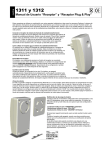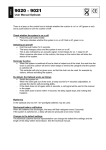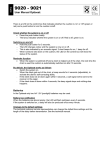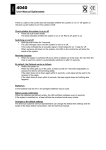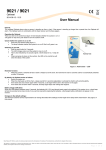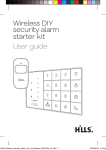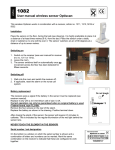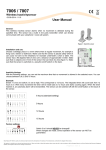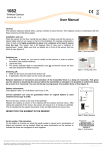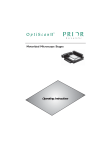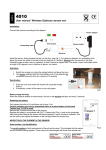Transcript
English 1311 and 1312 User manual “Receiver” and “Plug & Play Receiver” These receivers are used in combination with various wireless equipment such as Optiscan sensors, the Optiseat chair alarm, door/window switches, neck chain pendant transmitters (with and without man-down function), etc. The manner in which these receivers function depends on their programming. Because it is not possible to provide a separate user manual for each configuration, this manual is based upon the standard (most common) situation. Connection of the receiver to a nurse call system: Place the receiver in the electrical socket near the connection for the nurse call system. Because the Plug & Play receiver (art. no. 1312) obtains power via the link cable, this step does not apply to this model. Use the provided cable to connect the receiver to the nurse call system. After several seconds a short beep will be heard. The receiver is now ready for use. Use of the receiver without a nurse call system When no nurse call system is present, the receiver will be programmed to produce an acoustic signal. Place it in an electrical socket where the caregiver can hear the alarm. This must, however, be within range of the transmitter that is configured to this receiver (on average 40 metres). Always test the range. Switching on the receiver By default, pressing the button on the receiver will switch it on and cause a green lamp in the button to light. It may be, however, that due to a change to the receiver’s programming the button must be held for several seconds before it will switch on or off. If may also be (if so configured) that the green lamp goes out after two seconds. Upon alarm During an alarm the red lamp in the button will light. By default, this will also automatically go out. Depending on the programming, it may be that it remains lit until confirmation is received from the caregiver. In this case, the alarm is confirmed by pressing the button. This option will often be used if no nurse call system is present; the receiver will continue to beep until it is reset. Alarm zones In total, 16 different transmitters can be configured to 1 receiver. This receiver works with zone programming. This means that certain devices are configured to the appropriate zone. There are a total of 3 types of zones. Of these, two produce alarms even when the receiver is off. These are used for devices such as the neck chain pendant transmitter (with or without man-down function), the Optiseat chair alarm, door switches and smoke detectors. The Optiscan sensor is configured to the zone that is controlled via the on/off function. In this manner, in a situation where both an Optiscan sensor and a neck chain pendant transmitter are configured to a single receiver, it is possible to switch the Optiscan off via the receiver while the alarms from the neck chain pendant transmitter are still produced. Discharged battery notification When the battery of a configured transmitter is almost discharged, the red LED will flash several times every three seconds. The number of times the red LED flashes, indicates the zone in which the transmitter is configured. 1 pulse is the “STANDARD” zone 2 pulses is the “FALL-DET” zone 3 pulse is the “24hZONE” zone The transmitter will continue to operate, but replace the battery as soon as possible. When the receiver is switched off, an alarm tone will also sound to indicate that a discharged battery notification is stored in memory. On the rear is a sticker on which a combination of letters and numbers can be marked. Mark the same combination on a configured device, such as an Optiscan sensor, to indicate that these are configured to work together. Although this (1311) receiver has an earthed plug, it don't require an earthed wall socket. this receiver is double insulated, therefore the earth pin is not connected.
